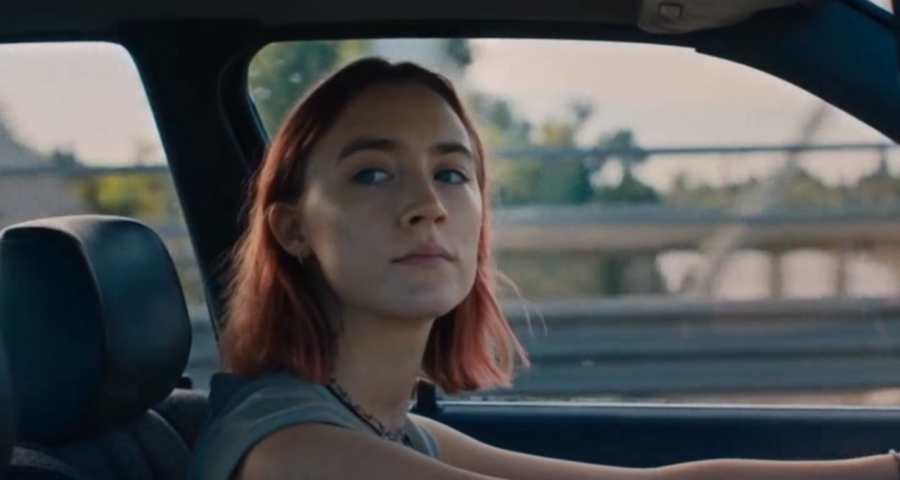An analysis of Greta Gerwig’s “Lady Bird”
Don’t you hate it when mothers relentlessly nag you over and over again, clinging onto a topic or idea with a death grip, refusing to ever let go? Well, that was my mom during the 2017 Christmas break.
“Let’s go see ‘Lady Bird,’ Abby,” she said. “Get your siblings and let’s go see ‘Lady Bird,’ Abby,” she said five minutes later. Blah, blah, blah. Lady Bird, Lady Bird, Lady Bird.
Naturally, this nagging prompted a growing dislike for the movie, even though I hadn’t yet seen it— my mom’s voice haunted my nightmares, even just the name “Lady Bird” elicited a pain similar to that of a blistering mosquito bite that never stops itching.
But then, finally, the itch went away— I watched the film. As I sat with my mom directly to the right of me, my slouchy posture and stubborn mindset slowly switched to an edge-of-the-seat excitement and wide eyes. No longer was “Lady Bird” the annoyance in the back of my head— the film consumed my thoughts in a good way. The voice in my head was no longer my mother’s, it was mine, screaming Lady Bird, Lady Bird, LADY BIRD!!!
Christine McPherson, the film’s protagonist, is a senior at a Catholic all-girls school who has renamed herself “Lady Bird.” The film follows this angsty teenager as she struggles with typical adolescent problems: first loves and heart-breaks, hard-to-please mothers and nurturing fathers, loyal best friends and mean popular girls, to name a few.
Yet, the movie is anything but typical.
Greta Gerwig (director of “Lady Bird”) brings a surprising freshness and authenticity to this stereotypical and predictable American genre. From the young, talented cast to the impeccable script, Gerwig’s characters transcend the screen and touch every heart in the audience— making it look easy.
The movie perfectly imitates the intricate relationship between a strict, somewhat cold-hearted mother and a stubborn, rebellious daughter. Lady Bird constantly battles to express her absurd individuality in both her public life and in private relationship with her mother, the latter appearing an impossible task. Despite its somewhat rocky mother-daughter relationship, the movie shows the underlying importance of that relationship, proving it to be essential.
In one scene, Lady Bird and her mom (played by Laurie Metclaf) shop at a thrift store together, a seemingly ordinary task that should bore viewers into a nap. But, through the pastel-colored cinematography and clear-cut execution, the scene is one of my favorites.
Ordering Lady Bird to pick up her feet, Marion (Lady Bird’s mom) changes the once friendly atmosphere into a war zone. Now adopting an irritable and toddler-like attitude, Lady Bird dramatically rolls her eyes as they engage in a whispered, spiteful argument in the middle of the store. But it suddenly all ends when Marion pulls out the perfect homecoming dress and Lady Bird responds, “Oh I love that.”
As an angsty teenager myself, this portrayal of the “typical” mother-daughter relationship is accurate to a tee. I sat in the theater laughing because everything on the screen correlated with certain aspects of my life.
But, that portrayal does not just go one way. I walked out of the theater saying ‘See mom? That’s how you are!’ and my mom replied, ‘No Abby, that’s how you are!” Gerwig expertly reveals two sides of the story, almost taunting the audience when the two main characters fail again and again to express their honest emotions.
For example, my second favorite scene has Saoirse Ronan (Lady Bird) leaving for college, a college her mother disapproves of. Hoping her mom at least will be there to send her off, Lady Bird waits for her mother’s support. However, in this painful scene, Marion drives off without saying goodbye to Lady Bird. The camera pans to Marion, who slowly, second by second, starts to breakdown while driving at the wheel. Finally, she frantically decided to turn around and pulls into the airport, running in after her daughter. Much to the dismay of both the audience and Marion, however, Lady Bird has already left, carrying the notion that her mother didn’t even care enough to say goodbye. Marion was too late. A dagger in the heart indeed, but an all-too-true analysis of mother-daughter troubles.
And “Lady Bird” does just that— it speaks to these mother-daughter woes. It allows the audience to watch a teenage girl grow in front of your eyes, with all the bumps and bruises life inflicts, and leaving with newfound appreciation to life’s messy process.
Personally, I left with a deep appreciation for my own mom. The film connected me to her, and just like Lady Bird’s situation, it remained unspoken, yet significant.
“Lady Bird” entered into cinema as one of A24’s best productions. While providing iconic punch lines and light-hearted jokes, it also knocks the breath out of its audience with heavy scenes and depressing, yet truthful, moments.
“Lady Bird” is a must watch, especially with your mother sitting right beside. Because, while Lady Bird might be a dysfunctional teen, “Lady Bird” is perfection.
